#consecrated secular
Text
Always something new to learn! 🤓

0 notes
Text
Off to Omaha, Nebraska to renew my promises and (more importantly) celebrate my sisters who are making their first consecration and renewing for life! Please keep us in your prayers!
10 notes
·
View notes
Text
Bonus points for describing the scene in the tags.
(Taken from the Wikipedia article on excommunicatable offenses in the Catholic Church)
#the locked tomb#atn#alectopause#tlt polls#have fun with my stupid poll :)#i hope this one takes off i think its really funny#simony: ianthe yard sales all the dead lyctors shit while john is depressed
19 notes
·
View notes
Text
Details on the Coronation Regalia
The heart of the Crown Jewels and housed in the Tower of London where they are kept on public display, the Coronation Regalia are sacred and secular objects which symbolise the service and responsibilities of the monarch. The Regalia have played a central role in Coronation Services for hundreds of years and, in keeping with tradition, will be used at Westminster Abbey on the 6 th May. As part of the Royal Collection, the Regalia are held in trust by the Monarch on behalf of the nation.

Two Maces, made of silver gilt over oak, date between 1660 and 1695 and are the ceremonial emblems of authority which are carried before the Sovereign at events such as the State Opening of Parliament. Also carried before the Sovereign on formal occasions is the Sword of State, symbolising Royal authority; a steel blade with a silver-gilt hilt, enclosed in a wooden scabbard which is covered in velvet. In 1660 and 1678, during the reign of King Charles II, two such swords were made, the elder of which has not survived. The remaining sword has been used at several Coronations and, in 1969, the Investiture of The Prince of Wales. The sword is carried with the point upwards, and the scabbard carries the coat of arms of King William III.
Three further swords will be used during the Coronation Procession at Westminster Abbey; the Sword of Temporal Justice, signifying the Monarch’s role as Head of the Armed Forces, the Sword of Spiritual Justice, signifying the Monarch as Defender of the Faith, and the Sword of Mercy or Curtana, which has a blunted tip, symbolising the Sovereign’s mercy. The swords were first used at the Coronation of King Charles I in 1626, and the steel blades date back to the sixteenth century, with early seventeenth century gilt-iron hilts, and wire-bound grips. The three swords are carried without their scabbards, with their points up.

The golden St Edward’s Staff, with its steel spike, was created by the Crown Jeweller, Robert Vyner, in 1661. It derives from an earlier staff which was often referred to as the ‘Long Sceptre’ and carried in fifteenth and sixteenth century Coronation processions as a relic of the Royal saint, Edward the Confessor.

The Chrism oil with which The King and The Queen Consort will be anointed, which was consecrated in The Church of the Holy Sepulchre in Jerusalem in March, will be contained within the Ampulla, made from gold and cast in the form of an eagle with outspread wings. The oil is poured through an aperture in the beak. The Ampulla was supplied for the coronation of King Charles II in 1661 by the Crown Jeweller, Robert Vyner, and is based on an earlier, smaller vessel, which in turn was based on a fourteenth-century legend in which the Virgin Mary appeared to St Thomas à Becket and presented him with a golden eagle and a vial of oil for anointing future Kings of England.
The silver-gilt Coronation Spoon is the oldest object in use at Coronations, having been first recorded in 1349 among St Edward’s Regalia in Westminster Abbey, and is the only piece of Royal goldsmiths’ work to survive from the twelfth century, having possibly been supplied to King Henry II (1133-1189) or King Richard I (1157-1199). It was used to anoint King James I in 1603, and at every subsequent Coronation. In 1649, the Spoon was sold to the Yeoman of King Charles I’s Wardrobe, who returned it for King Charles II’s Coronation in 1661, when small seed pearls were added to the decoration of the handle.
The Spurs were made in 1661 for King Charles II, but the use of spurs at Coronations dates back to King Richard I, the Lionheart, and his Coronation in 1189. The gold, leather and velvet Spurs symbolise knighthood, and they were altered in 1820 for King George IV.

The Sword of Offering was made in 1820, and has a steel blade, mounted in gold and set with jewels, which form a rose, a thistle, a shamrock, oak leaves, acorns, and lion’s heads. The sword is contained in a gold-covered leather scabbard. It was first used at the Coronation of King George IV.
The two Armills are bracelets made from gold, champlevé and basse-taille enamel, lined in velvet, and are thought to relate to ancient symbols of knighthood and military leadership. They have been referred to during previous Coronations as the 'bracelets of sincerity and wisdom'. The Armills date back to 1661 and have been used at every Coronation from King Charles II’s until King George VI’s in 1937.
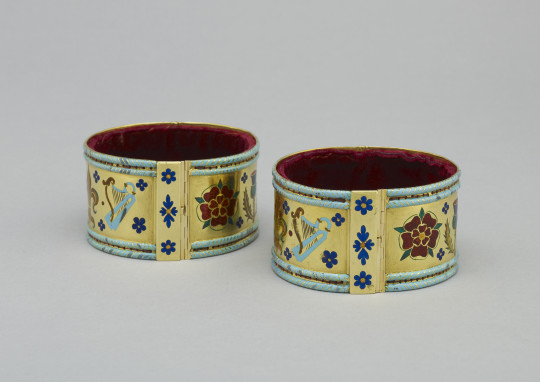
A representation of the Sovereign’s power and symbolising the Christian world, the Sovereign’s Orb was made from gold in the seventeenth century, and is divided into three sections with bands of jewels, for each of the three continents known in medieval period.

The Sovereign’s Ring is composed of a sapphire with a ruby cross set in diamonds. A symbol of kingly dignity, the ring was made for the Coronation of King William IV in 1831, and all Sovereigns from King Edward VII onwards have used it at their Coronations.
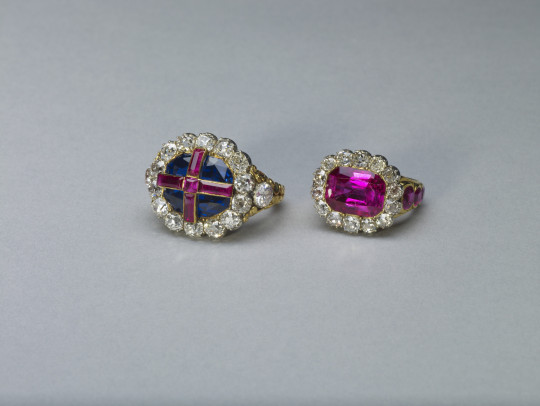
The two Sovereign’s Sceptres will be used at Coronation. The Sovereign’s Sceptre with Cross represents the sovereign's temporal power and is associated with good governance. It comprises a gold rod, surmounted by an enamelled heart-shaped structure which holds the Cullinan I diamond. The sceptre was created for King Charles II, and the Cullinan I was added in 1901. The Sovereign’s Sceptre with Dove, traditionally known as ‘the Rod of Equity and Mercy', represents the Sovereign’s spiritual role, with the enamelled dove with outspread wings representing the Holy Ghost. It was created by the Crown Jeweller, Robert Vyner in 1661.

As previously announced, St Edward’s Crown will be used to crown His Majesty The King at Westminster Abbey on 6th May, according to tradition. The crown was made for King Charles II in 1661, as a replacement for the medieval crown which had been melted down in 1649. The original was thought to date back to the eleventh-century royal saint, Edward the Confessor – the last AngloSaxon king of England. The crown was commissioned from the Crown Jeweller, Robert Vyner, in 1661. Although it is not an exact replica of the medieval design, it follows the original in having four crosses-pattée and four fleurs-de-lis, and two arches. The crown is topped with an orb and a cross, symbolising the Christian world, and is made up of a solid gold frame set with rubies, amethysts, sapphires, garnet, topazes and tourmalines. The crown has a velvet cap with an ermine band. St Edward’s Crown was worn by Queen Elizabeth II at the Coronation in 1953. The crown has been removed from the Tower of London to allow for modification work ahead of the Coronation.
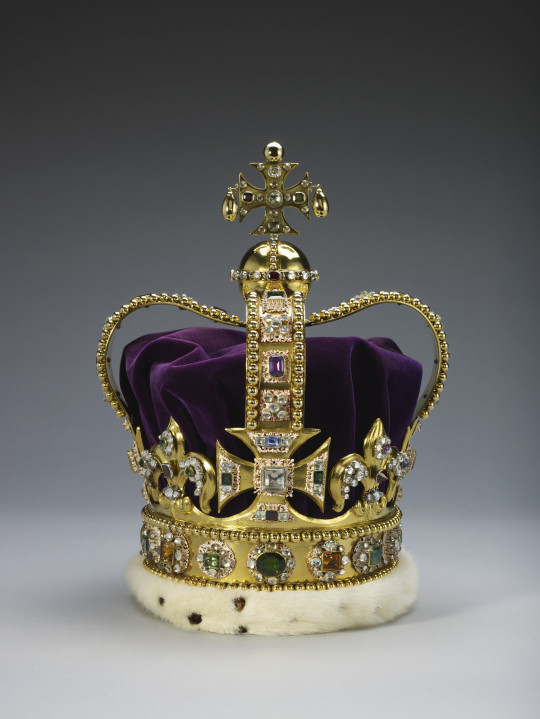
The Queen Consort’s Ring, a ruby in a gold setting, was made for the Coronation of King William IV and Queen Adelaide in 1831, and has been used by three further Queens Consort; Queen Alexandra, Queen Mary, and Queen Elizabeth The Queen Mother.
Mirroring the Sovereign’s Sceptre with Dove, the Queen Consort’s Rod with Dove is symbolic of ‘equity and mercy’ and the dove, with its folded wings, is symbolic of the Holy Ghost. The Queen Consort’s Sceptre with Cross was originally supplied for the coronation of Mary of Modena, Queen Consort of James II, in 1685 by Robert Vyner, and is inlaid with rock crystals.
Queen Mary’s Crown has been chosen by The Queen Consort for the Coronation, as previously announced, marking the first instance in modern times of an existing crown being used for the Coronation of the Consort. Ahead of the Coronation, minor changes and additions to Queen Mary’s Crown are being undertaken, such as the as inclusion of the Cullinan III, IV and V diamonds which were part of Queen Elizabeth II’s personal jewellery collection for many years. The design was inspired by Queen Alexandra’s Crown of 1902. Like Queen Alexandra’s Crown, it can be worn without the arches in the form of a circlet, which Queen Mary wore for the Coronation of her son, King George VI, in 1937.

The Imperial State Crown, or Crown of State, is the crown the monarch exchanges for St Edward's Crown at the end of the Coronation Service. The Imperial State Crown is also used on ceremonial occasions, such as the State Opening of Parliament. The term “imperial state crown” dates back to the fifteenth century when English monarchs chose a crown design closed by arches to demonstrate that England was not subject to any other earthly power. This Imperial State Crown was made for the Coronation of King George VI in 1937, but is closely based on a crown designed for Queen Victoria in 1838 by the Crown Jewellers of the time, Rundell, Bridge & Rundell.
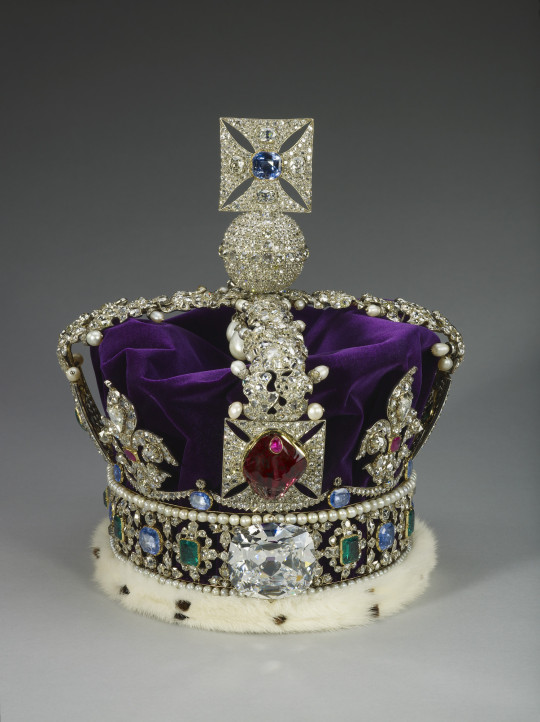
78 notes
·
View notes
Text
Saints&Reading: Tuesday , January 23, 2024
january 9_january 23
ST. THEOPHAN THE RECLUSE, BISHOP OF TAMBOV (1894)
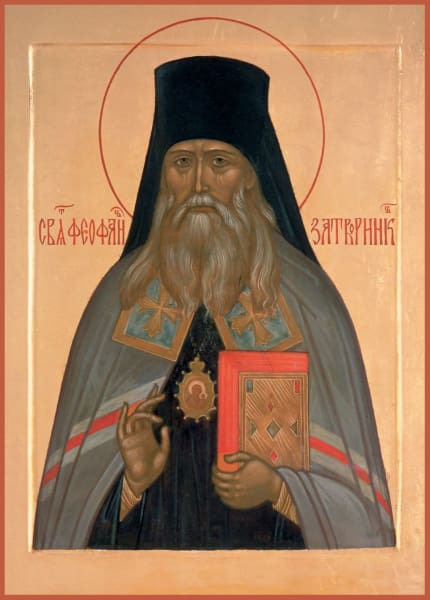
George Govorov, the future Saint Theophan, was born on January 10, 1815 in the village of Chernavsk in the Orlov province where his father was a priest.
At first, George attended a primary school at Liven, then a military school. From 1837-1841 he studied at the Kiev Theological Academy, and probably visited the Monastery of the Caves several times. In these surroundings, it was not surprising that he received the monastic tonsure while he was still a student. After graduation Hieromonk Theophan was appointed rector of Kiev’s church schools, and later became rector of the seminary in Novgorod. Before he retired from teaching, Father Theophan served as a professor and Assistant Inspector at the Petersburg Academy.
Saint Theophan was not completely happy with academic work, so he asked to be relieved of his duties. He was assigned to be a member of the Russian Mission in Jerusalem. After being raised to the rank of Archimandrite, he became Rector of Olnets Seminary. Soon he was assigned as the chief priest of the embassy church in Constantinople. Saint Theophan was eventually recalled to Russia to become rector of the Petersburg Academy, and supervisor of religious education in the capital’s secular schools.
On May 9, 1859 Saint Theophan was consecrated as Bishop of Tambov, where he established a diocesan school for girls. During his time in Tambov he came to love the secluded Vysha Monastery in his diocese. In 1863 he was transferred to Vladimir and remained there for three years. He also established a diocesan school for girls at Vladimir.
The holy bishop visited parishes throughout his diocese serving, preaching, restoring churches, and sharing the joys and sorrows of his flock. It was very difficult for Bishop Theophan to live in the world and become involved with vain worldly disputes. Many abused his trust, but he could not bring himself to chastise anyone. Instead, he left such unpleasant tasks to the Archpriest of his cathedral.
He was present at the uncovering of the relics of Saint Tikhon of in 1861, and this made a tremendous impression on him, for he had much in common with that saint. He had loved Saint Tikhon from early childhood, and always spoke about him with great enthusiasm. When Saint Tikhon was glorified as a saint on August 13, Bishop Theophan’s joy knew no bounds.
In 1866 his request to be relieved of his duties as Bishop of Vladimir was granted. He was appointed as Superior of the Vysha Monastery, but soon resigned from that position. He was permitted to live there and to celebrate services whenever he wished. He also received a pension of 1000 rubles.
As he prepared to leave his diocese, he wished to focus on his own salvation, and to concentrate on undisturbed communion with God. On July 24, 1866 he bade his diocese farewell, leaving the world for a life of reclusion, and to devote himself to writing spiritual books. Through these books, Saint Theophan has become the spiritual benefector of all Orthodox Christians. Although he sought the Kingdom of God and His righteousness (Mt. 6:33), a reputation as a writer of great significance for the whole world was also added to him.
Bishop Theophan wrote many books, but received no profits from their sale. He tried to keep them as inexpensive as possible, and they quickly sold out. He wrote about topics which others before him had not fully treated, such as how to live a Christian life, how to overcome sinful habits, and how to avoid despair. He tried to explain the steps of spiritual perfection systematically, as one who had himself gone through these various steps. Some of his books include The Spiritual Life and How to be Attuned to It, The Path to Salvation, and Letters on the Spiritual Life. He also translated the Philokalia in five volumes, and The Sermons of Saint Simeon the New Theologian.
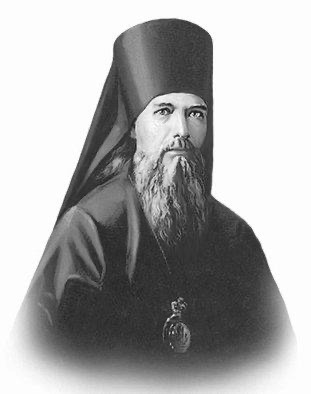
For the first six years in the monastery, Bishop Theophan attended all the services, including the early Liturgy. He stood still in church with his eyes closed so that he would not be distracted. He often celebrated Liturgy on Sundays and Feast Days.
Beginning in 1872, he cut off all relationships with people (except for his confessor) and no longer left his cell to attend church. He built a small chapel in his quarters and dedicated it to the Lord’s Baptism. For ten years he served there on Sundays and Feast Days. For the last eleven years of his life he served every day by himself. Sometimes he would sing, and sometimes he kept completely silent.
Whenever anyone visited him on business, Bishop Theophan would reply with as few words as possible, then immerse himself in prayer. If anyone sent him money, he would distribute it to the poor, keeping only a small portion to purchase books.
Whenever he was not occupied with writing or praying, the reclusive bishop worked at carpentry or painting icons. He received from twenty to forty letters each day, and he answered all of them. He was able to discern each writer’s spiritual condition, then give detailed answers to the questions of those who were struggling for the salvation of their souls.
His eyesight deteriorated in his latter years, but he did not curtail his work because of it. In the evening, his cell attendant would prepare everything for the bishop to serve Liturgy the next morning. After finishing the Liturgy, Bishop Theophan would knock on the wall to signal the cell attendant to serve him tea. On days when there was no fasting, he would eat lunch at 1:00 P.M. This consisted of one egg and a glass of milk. At four o’clock he would have some tea, and then no more food that day.
Bishop Theophan began to get weaker at the beginning of 1894. He was still writing on the afternoon of January 6, but when the cell attendant came to check on him at 4:30 he found that the bishop had departed to the Lord.
Saint Theophan’s body lay in the small church in his cell for three days, then three more days in the cathedral. There was no trace of corruption, however. He was laid to rest in the Kazan church of the Vysha Monastery.
Several of Saint Theophan’s books have been translated into English, and are reliable spiritual guides for Orthodox Christians of today. Saint Theophan’s gift was the ability to present the wisdom of the Fathers in terms which modern people can understand. Since he lived close to our own time, many readers find his books “more approachable” than the earlier patristic literature. He treats the life of the soul and the life of the body as a unified whole, not as two separate elements, and reveals to people the path of salvation.
SAINT THEOSEBIA, THE DEACONESS SISTER OF ST BASIL AND GREGORY OF NYSSA (385)
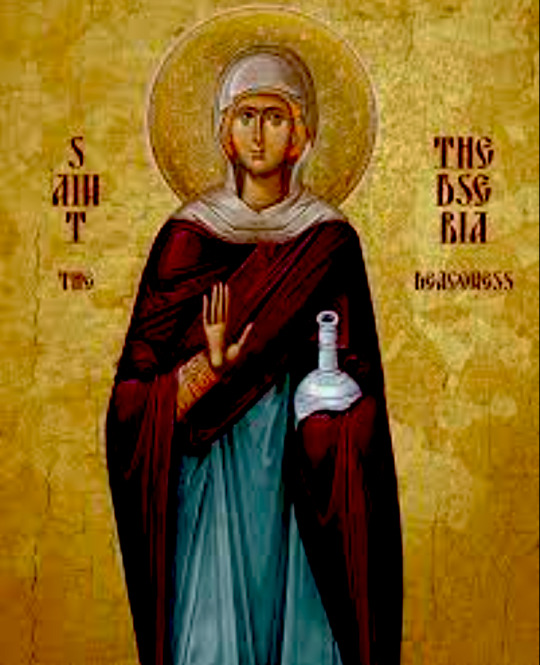
Saint Theosebia the Deaconess was the sister of Saints Basil the Great, Gregory, afterward Bishop of Nyssa, and Peter, Bishop of Sebaste. She was a virgin and served the Holy Church as a deaconess, caring for the sick, distributing food to vagrants, raising orphans and preparing women for holy Baptism.
When her brother, Saint Gregory of Nyssa, was in exile for three years, Saint Theosebia was with him and she shared in all the tribulations of a life of wandering. Saint Theosebia died in 385, and Saint Gregory the Theologian praised her in a eulogy.
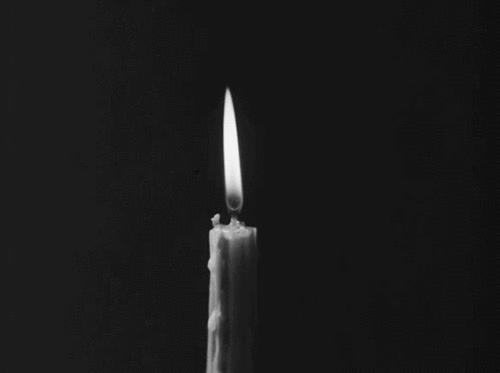
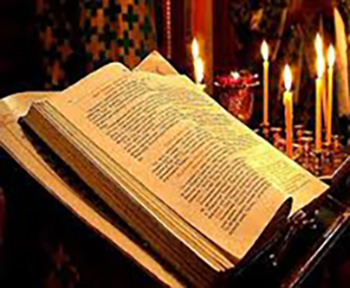
HEBREWS 9:8-10, 15-23
8 the Holy Spirit indicating this, that the way into the Holiest of All was not yet made manifest while the first tabernacle was still standing. 9 It was symbolic for the present time in which both gifts and sacrifices are offered which cannot make him who performed the service perfect in regard to the conscience- 10 concerned only with foods and drinks, various washings, and fleshly ordinances imposed until the time of reformation. 15 And for this reason He is the Mediator of the new covenant, by means of death, for the redemption of the transgressions under the first covenant, that those who are called may receive the promise of the eternal inheritance. 16 For where there is a testament, there must also of necessity be the death of the testator. 17 For a testament is in force after men are dead, since it has no power at all while the testator lives. 18 Therefore not even the first covenant was dedicated without blood. 19 For when Moses had spoken every precept to all the people according to the law, he took the blood of calves and goats, with water, scarlet wool, and hyssop, and sprinkled both the book itself and all the people, 20 saying, "This is the blood of the covenant which God has commanded you." 21 Then likewise he sprinkled with blood both the tabernacle and all the vessels of the ministry. 22 And according to the law almost all things are purified with blood, and without shedding of blood there is no remission. 23 Therefore it was necessary that the copies of the things in the heavens should be purified with these, but the heavenly things themselves with better sacrifices than these.
JOHN 10:9-16
9I am the door. If anyone enters by Me, he will be saved, and will go in and out and find pasture. 10 The thief does not come except to steal, and to kill, and to destroy. I have come that they may have life, and that they may have it more abundantly. 11 I am the good shepherd. The good shepherd gives His life for the sheep. 12 But a hireling, he who is not the shepherd, one who does not own the sheep, sees the wolf coming and leaves the sheep and flees; and the wolf catches the sheep and scatters them. 13 The hireling flees because he is a hireling and does not care about the sheep. 14 I am the good shepherd; and I know My sheep, and am known by My own. 15 As the Father knows Me, even so I know the Father; and I lay down My life for the sheep.
#orthodoxy#orthodoxchristianity#easternorthodoxchurch#originofchristianity#spirituality#holyscriptures#gospel#bible#saints#wisdom
10 notes
·
View notes
Text
The Coronation Regalia
The heart of the Crown Jewels and housed in the Tower of London where they are kept on public display, the Coronation Regalia are sacred and secular objects which symbolise the service and responsibilities of the monarch. The Regalia have played a central role in Coronation Services for hundreds of years and, in keeping with tradition, will be used at Westminster Abbey on the 6 th May. As part of the Royal Collection, the Regalia are held in trust by the Monarch on behalf of the nation.

Two Maces, made of silver gilt over oak, date between 1660 and 1695 and are the ceremonial emblems of authority which are carried before the Sovereign at events such as the State Opening of Parliament. Also carried before the Sovereign on formal occasions is the Sword of State, symbolising Royal authority; a steel blade with a silver-gilt hilt, enclosed in a wooden scabbard which is covered in velvet. In 1660 and 1678, during the reign of King Charles II, two such swords were made, the elder of which has not survived. The remaining sword has been used at several Coronations and, in 1969, the Investiture of The Prince of Wales. The sword is carried with the point upwards, and the scabbard carries the coat of arms of King William III.
Three further swords will be used during the Coronation Procession at Westminster Abbey; the Sword of Temporal Justice, signifying the Monarch’s role as Head of the Armed Forces, the Sword of Spiritual Justice, signifying the Monarch as Defender of the Faith, and the Sword of Mercy or Curtana, which has a blunted tip, symbolising the Sovereign’s mercy. The swords were first used at the Coronation of King Charles I in 1626, and the steel blades date back to the sixteenth century, with early seventeenth century gilt-iron hilts, and wire-bound grips. The three swords are carried without their scabbards, with their points up.

The golden St Edward’s Staff, with its steel spike, was created by the Crown Jeweller, Robert Vyner, in 1661. It derives from an earlier staff which was often referred to as the ‘Long Sceptre’ and carried in fifteenth and sixteenth century Coronation processions as a relic of the Royal saint, Edward the Confessor.

The Chrism oil with which The King and The Queen Consort will be anointed, which was consecrated in The Church of the Holy Sepulchre in Jerusalem in March, will be contained within the Ampulla, made from gold and cast in the form of an eagle with outspread wings. The oil is poured through an aperture in the beak. The Ampulla was supplied for the coronation of King Charles II in 1661 by the Crown Jeweller, Robert Vyner, and is based on an earlier, smaller vessel, which in turn was based on a fourteenth-century legend in which the Virgin Mary appeared to St Thomas à Becket and presented him with a golden eagle and a vial of oil for anointing future Kings of England.
The silver-gilt Coronation Spoon is the oldest object in use at Coronations, having been first recorded in 1349 among St Edward’s Regalia in Westminster Abbey, and is the only piece of Royal goldsmiths’ work to survive from the twelfth century, having possibly been supplied to King Henry II (1133-1189) or King Richard I (1157-1199). It was used to anoint King James I in 1603, and at every subsequent Coronation. In 1649, the Spoon was sold to the Yeoman of King Charles I’s Wardrobe, who returned it for King Charles II’s Coronation in 1661, when small seed pearls were added to the decoration of the handle.
The Spurs were made in 1661 for King Charles II, but the use of spurs at Coronations dates back to King Richard I, the Lionheart, and his Coronation in 1189. The gold, leather and velvet Spurs symbolise knighthood, and they were altered in 1820 for King George IV.

The Sword of Offering was made in 1820, and has a steel blade, mounted in gold and set with jewels, which form a rose, a thistle, a shamrock, oak leaves, acorns, and lion’s heads. The sword is contained in a gold-covered leather scabbard. It was first used at the Coronation of King George IV.
The two Armills are bracelets made from gold, champlevé and basse-taille enamel, lined in velvet, and are thought to relate to ancient symbols of knighthood and military leadership. They have been referred to during previous Coronations as the 'bracelets of sincerity and wisdom'. The Armills date back to 1661 and have been used at every Coronation from King Charles II’s until King George VI’s in 1937.
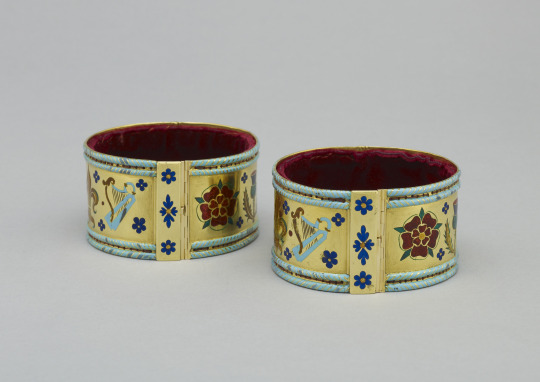
A representation of the Sovereign’s power and symbolising the Christian world, the Sovereign’s Orb was made from gold in the seventeenth century, and is divided into three sections with bands of jewels, for each of the three continents known in medieval period.

The Sovereign’s Ring is composed of a sapphire with a ruby cross set in diamonds. A symbol of kingly dignity, the ring was made for the Coronation of King William IV in 1831, and all Sovereigns from King Edward VII onwards have used it at their Coronations.
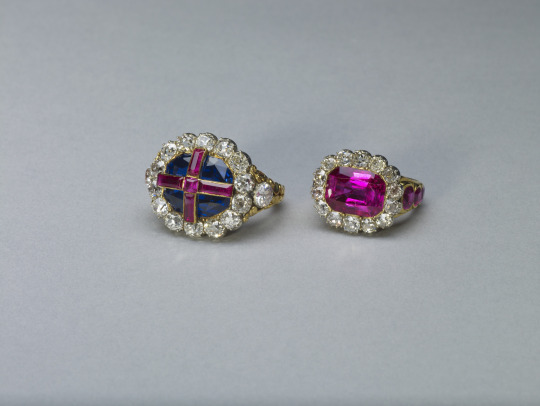
The two Sovereign’s Sceptres will be used at Coronation. The Sovereign’s Sceptre with Cross represents the sovereign's temporal power and is associated with good governance. It comprises a gold rod, surmounted by an enamelled heart-shaped structure which holds the Cullinan I diamond. The sceptre was created for King Charles II, and the Cullinan I was added in 1901. The Sovereign’s Sceptre with Dove, traditionally known as ‘the Rod of Equity and Mercy', represents the Sovereign’s spiritual role, with the enamelled dove with outspread wings representing the Holy Ghost. It was created by the Crown Jeweller, Robert Vyner in 1661.
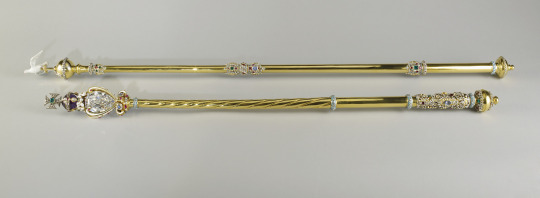
As previously announced, St Edward’s Crown will be used to crown His Majesty The King at Westminster Abbey on 6th May, according to tradition. The crown was made for King Charles II in 1661, as a replacement for the medieval crown which had been melted down in 1649. The original was thought to date back to the eleventh-century royal saint, Edward the Confessor – the last AngloSaxon king of England. The crown was commissioned from the Crown Jeweller, Robert Vyner, in 1661. Although it is not an exact replica of the medieval design, it follows the original in having four crosses-pattée and four fleurs-de-lis, and two arches. The crown is topped with an orb and a cross, symbolising the Christian world, and is made up of a solid gold frame set with rubies, amethysts, sapphires, garnet, topazes and tourmalines. The crown has a velvet cap with an ermine band. St Edward’s Crown was worn by Queen Elizabeth II at the Coronation in 1953. The crown has been removed from the Tower of London to allow for modification work ahead of the Coronation.
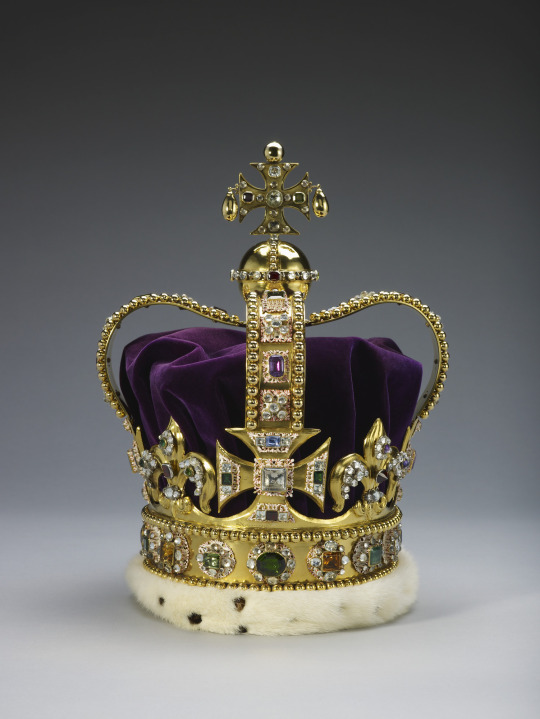
The Queen Consort’s Ring, a ruby in a gold setting, was made for the Coronation of King William IV and Queen Adelaide in 1831, and has been used by three further Queens Consort; Queen Alexandra, Queen Mary, and Queen Elizabeth The Queen Mother.
Mirroring the Sovereign’s Sceptre with Dove, the Queen Consort’s Rod with Dove is symbolic of ‘equity and mercy’ and the dove, with its folded wings, is symbolic of the Holy Ghost. The Queen Consort’s Sceptre with Cross was originally supplied for the coronation of Mary of Modena, Queen Consort of James II, in 1685 by Robert Vyner, and is inlaid with rock crystals.
Queen Mary’s Crown has been chosen by The Queen Consort for the Coronation, as previously announced, marking the first instance in modern times of an existing crown being used for the Coronation of the Consort. Ahead of the Coronation, minor changes and additions to Queen Mary’s Crown are being undertaken, such as the as inclusion of the Cullinan III, IV and V diamonds which were part of Queen Elizabeth II’s personal jewellery collection for many years. The design was inspired by Queen Alexandra’s Crown of 1902. Like Queen Alexandra’s Crown, it can be worn without the arches in the form of a circlet, which Queen Mary wore for the Coronation of her son, King George VI, in 1937.

The Imperial State Crown, or Crown of State, is the crown the monarch exchanges for St Edward's Crown at the end of the Coronation Service. The Imperial State Crown is also used on ceremonial occasions, such as the State Opening of Parliament. The term “imperial state crown” dates back to the fifteenth century when English monarchs chose a crown design closed by arches to demonstrate that England was not subject to any other earthly power. This Imperial State Crown was made for the Coronation of King George VI in 1937, but is closely based on a crown designed for Queen Victoria in 1838 by the Crown Jewellers of the time, Rundell, Bridge & Rundell.

36 notes
·
View notes
Text
Indian Prime Minister Narendra Modi has inaugurated a grand temple to Hindu god Ram in the flashpoint city of Ayodhya.
He said it heralded "a new era" for India - the temple replaces a 16th-Century mosque torn down by Hindu mobs in 1992, sparking riots in which nearly 2,000 people died.
Top film stars and cricketers were among guests at the event in Ayodhya.
But some Hindu seers and most of the opposition boycotted it, saying Mr Modi was using it for political gain.
General elections are due in India in the next few months and Mr Modi's political rivals say the governing Bharatiya Janata Party (BJP) will be seeking votes in the temple's name in a country where 80% of the population is Hindu.
Critics have also accused the government of exploiting a religious celebration in a country which - according to its constitution - is secular. For Muslims, India's biggest minority, the event evoked fear and painful memories, members of the community in Ayodhya told the BBC in the run-up to Monday's ceremony.
Televised live, it showed Mr Modi performing religious rituals inside the temple's sanctum along with priests and Mohan Bhagwat, head of the Rashtriya Swayamsevak Sangh (RSS) - the ideological fountainhead of Hindu nationalist parties.
The complex history of India's Ayodhya holy site
Transforming a flashpoint holy city into the ‘Hindu Vatican’
"Today's date will go down in history," Mr Modi said after the event. "After years of struggle and countless sacrifices, Lord Ram has arrived [home]. I want to congratulate every citizen of the country on this historic occasion."
The temple has been constructed at a cost of $217m (£170m), funded from private donations. Only the ground floor was opened - the rest is expected to be completed by the end of the year. The construction work is part of a revamp for the city, estimated to cost more than $3bn.
The building of the Ram temple in Ayodhya fulfils a decades-long Hindu nationalist pledge. Many Hindus believe the Babri mosque was built by Muslim invaders on the ruins of a temple where the Hindu god was born.
The movement to build the temple helped propel the BJP into political prominence in the 1990s.
There was a festive atmosphere as tens of thousands of chanting Hindu devotees waved flags and beat drums - military helicopters showered flower petals on the temple. Saffron flags with pictures of Lord Ram line streets in the city festooned with marigolds, as do banners with the faces of Mr Modi and Uttar Pradesh Chief Minister Yogi Adityanath.
Some of India's biggest celebrities, including Bollywood star Amitabh Bachchan and cricketer Sachin Tendulkar, attended.
Temple rises from ruins of one of India’s darkest days
Listen: The temple at the heart of Modi's India re-election bid
Transforming a flashpoint holy city into the ‘Hindu Vatican’
In many other northern cities Hindus lit lamps, and saffron flags carrying images of Ram are fluttering on rooftops, including in several parts of Delhi. Cinemas screened the event, and big screens relayed pictures from Ayodhya to town squares and residential neighbourhoods.
The ceremony, called Pran Pratishtha, which loosely translates from Sanskrit into "establishment of life force", lasted about an hour. Hindus believe that chanting mantras and performing rituals around a fire will infuse sacred life in an idol or a photograph of a deity.
Several domestic TV stations built huge sets by the side of the river Saryu, a tributary of the Ganges, just behind the temple, and provided wall-to-wall coverage of the event, some proclaiming the moment of consecration as the start of "Ram Rajya" (Lord Ram's rule) in India.
Hindus celebrated the inauguration in other countries too. Massive billboards of Lord Ram graced Times Square in New York, where a group of devotees braved the freezing weather to gather in the middle of the night.
Temples all across the United Kingdom - where Indians are one of the largest diaspora groups - marked the event. Colourful posters had been shared inviting devotees to honour the occasion and celebrations involved flowers, sweets and music. There were also some celebrations in Muslim-majority Dubai - where Indians are a significant population - but from Indian news reports these appeared more muted than elsewhere.
In 2019, the Supreme Court gave the disputed land to Hindus after a protracted legal battle followed the mosque's demolition. Muslims were given a plot outside the city for a mosque but have yet to build one.
One member of the community the BBC spoke to in Ayodhya ahead of Monday's inauguration agreed that Hindus have the right to build the temple after the Supreme Court gave them the site.
"We did not accept that decision happily, but what can we do," he said. Another man said he was happy Hindus are building the temple - "but we are also sad because it was built after destroying a mosque".
The new three-storey temple - made with pink sandstone and anchored by black granite - stretches across 7.2 acres in a 70-acre complex. A 51-inch (4.25-ft) statue of the deity, specially commissioned for the temple, was unveiled last week. The idol has been placed on a marble pedestal in the sanctum sanctorum.
Thousands of police were deployed for Monday's event, despite Mr Modi having appealed to pilgrims not to turn up and to watch the ceremony on television. In many states a full or half day holiday was called, with schools and colleges closed and stock markets shut.
The build-up to a demolition that shook India
The man who helped Lord Ram win the Ayodhya case
But a sour note was struck with some top religious seers saying that as the temple was not yet complete, it was against Hinduism to perform the rituals there, and many opposition leaders deciding to stay away.
Some opposition-ruled states also announced their own plans for the day - West Bengal Chief Minister Mamata Banerjee said she would pray at the iconic temple to goddess Kali in Kolkata and then lead an all-faith rally. The eastern state of Odisha (Orissa) unveiled huge plans to bring pilgrims to the Jagannath temple in Puri, one of the holiest sites for Hindus.
Authorities say they expect more than 150,000 visitors per day once the temple in Ayodhya is fully ready.
To accommodate this expected rush, new hotels are being built and existing ones spruced up as part of a major makeover and in recent weeks, a new airport and railway station have opened.
Officials say they are building a "world-class city where people come as pilgrims and tourists", but many local people have told the BBC that their homes, shops and "structures of religious nature" have been either completely or partially demolished to expand roads and set up other facilities.
7 notes
·
View notes
Text
Pagan religion did not depend on a very elaborate institutional structure, and the cults of each city were all organized locally; rabbinic Judaism, too, was very decentralized (Jews did have a single patriarch until around 425, but it is unclear how wide his powers were). Christianity, however, had a complex hierarchy, partly matching that of the state. By 400 there were four patriarchs, at Rome, Constantinople (since 381), Antioch and Alexandria (a fifth, Jerusalem, was added in 451), who oversaw the bishops of each city... Bishops were soon arrayed in two levels, with metropolitan bishops (called in later centuries archbishops) at an intermediate level, overseeing and consecrating the bishops of each secular province. Inside the dioceses of each bishop, which normally covered the secular territory of their city, bishops had authority over the clerics of other public churches... The church in the fourth and fifth centuries became an elaborate structure, with perhaps a hundred thousand clerics of different types, more than the civil administration, and steadily increasing in wealth as a result of pious gifts. It was not part of the state, but its wealth and empire-wide institutional cohesion made it an inevitable partner for emperors and prefects, and a strong and influential informal authority in cities; the cathedral church by 500 was often the largest local landowner (and therefore patron), and, unlike in the case of private family wealth, its stability could be guaranteed – bishops were not allowed to alienate church property... Even in a church context, bishops generally identified themselves with their diocese first, with wider ecclesiastical institutions only secondarily. But they were linked to the wider church hierarchy all the same: they could be called to order and dismissed by metropolitans and by the councils of bishops that steadily became more frequent, whether empire-wide (the ‘ecumenical’ councils) or at the regional level, in Spain or Gaul or Africa. The fact that this institutional structure did not depend on the empire, and was above all separately funded, meant that it could survive the political fragmentation of the fifth century, and the church was indeed the Roman institution that continued with least change into the early Middle Ages; the links between regions became weaker, but the rest remained intact.
Chris Wickham, chapter 3 of The Inheritance of Rome: Illuminating the Dark Ages 400-1000.
4 notes
·
View notes
Text
SAINT OF THE DAY (January 27)

Angela Merici, foundress of the Ursuline Sisters, was born in the small Italian town of Desenzano on the shore of Lake Garda on 21 March 1474.
As a young girl, Angela lost in succession to her sister and parents. She went to live with a wealthy uncle in the town of Salo where, without benefit of formal schooling, Angela grew in poise, wisdom, and grace.
The age in which Angela lived and worked was a time that saw great suffering on the part of the poor in society.
Injustices were carried on in the name of the government and the Church, which left many people, both spiritually and materially, powerless and hungry.
The corruption of moral values left families split and hurting. Wars among nations and the Italian city-states left towns in ruins.
In 1516, Angela came to live in the town of Brescia, Italy.
Here, she became a friend of the wealthy nobles of the day and a servant of the poor and suffering.
Angela spent her days in prayer and fasting and service.
Her reputation spread and her advice was sought by both young and old, rich and poor, religious and secular, male and female.
But still, Angela had not yet brought her vision to fruition.
After visiting the Holy Land, where she reportedly lost her sight, Angela returned to Brescia, which had become a haven for refugees from the many wars then wracking Italy.
There, she gathered around her a group of women who looked toward Angela as an inspirational leader and as a model of apostolic charity.
It was these women, many of them daughters of the wealthy, some orphans themselves, who formed the nucleus of Angela's Company of St. Ursula.
Angela named her company after St. Ursula because she regarded her as a model of consecrated virginity.
Angela and her original company worked out details of the rule of prayer, promises, and practices by which they were to live.
The Ursulines opened orphanages and schools.
In 1535, the Institute of St. Ursula was formally recognized by the Pope and Angela was accorded the title of foundress.
During the five remaining years of her life, Angela devoted herself to composing a number of Counsels by which her daughters could happily live.
She encouraged them to "live in harmony, united together in one heart and one will. Be bound to one another by the bond of charity, treating each other with respect, helping one another, bearing with one another in Christ Jesus.
If you really try to live like this, there is no doubt that the Lord our God will be in your midst."
In 1580, Charles Borromeo, Bishop of Milan, inspired by the work of the Ursulines in Brescia, encouraged the foundation of Ursuline houses in all the dioceses of Northern Italy.
Charles also encouraged the Ursulines to live together in community rather than in their own homes.
He also exhorted them to publicly profess vows of poverty, chastity, and obedience.
These actions formalized Angela's original "company" into a religious order of women.
Angela Merici died on 27 January 1540
She was beatified by Pope Clement XIII on 30 April 1768. She was canonized by Pope Pius VII on 24 May 1807.
6 notes
·
View notes
Text
Much of India came to a standstill on Jan. 22, when Indian Prime Minister Narendra Modi consecrated a temple in the northern city of Ayodhya commemorating Rama, a warrior-king worshipped by Hindus as a god. Schools, colleges, and offices closed and central government offices gave a half-day off to all employees. Some expectant parents even cajoled obstetricians to schedule cesarean sections on the day so that their children are born at the auspicious moment coinciding with the temple’s opening.
Such a public display of religiosity by the Indian government and its leadership may seem peculiar, particularly to those who cherish secularism. But India moved away from the state’s traditional interpretation of secularism a decade ago, when Modi led the Hindu nationalist Bharatiya Janata Party (BJP) to power. With the next national elections only a few months away, Modi has choreographed the Ram temple consecration to consolidate his Hindu vote (about 80 percent of the country’s population is Hindu). The political intent is clear: Cutouts of Modi grace lampposts on the airport road in Ayodhya, with similar images of Rama added almost as an afterthought. In an audio message on social media this month, Modi said, “God has made me an instrument to represent all the people of India.”
The ongoing construction of Ram Mandir is very controversial in India. From the early 16th century until 1992, a mosque known as Babri Masjid stood on the site—built during the time of the emperor Babur, the first Mughal to rule India. Many Hindus say that Babur destroyed a temple honoring Rama that previously stood on the land, which they believe is Rama’s birthplace. In the 1980s, Hindu activists began a movement to reclaim the site and build a temple there. In December 1992, they razed the mosque, an act that shocked the nation.
But in the past two decades, India has changed, and Hindus clamored for the land to be restored to them. In 2019, the Indian Supreme Court ruled that although the initial act of demolition was illegal, it would offer the site to a Hindu trust to build a temple and grant land elsewhere to a Muslim trust to rebuild a mosque. Although the construction of the Ram Mandir is not yet complete, Modi needs the imagery for his election campaign, and so the consecration will go ahead. Some opposition parties, including the Indian National Congress and the Communist Party of India, did not send their top leadership to the ceremony; however, some Congress leaders were divided over the boycott and at least two attended.
Rama, for many Hindus, is maryada purushottam—the ideal human being who sacrifices himself for others. His is the kind of life to which lesser mortals should aspire; his heroism is based not simply on battlecraft, but upon his ability to put others’ interests before his own. In the Sanskrit epic Ramayana, Rama is the prince of Ayodhya who is about to become king when one of his father’s wives demands that Rama go into exile, and the succession passes to her son instead. Rama leaves with his wife, Sita, and brother Lakshmana. The king of Lanka, Ravana, abducts Sita, and Rama mobilizes an army of monkeys to invade the island fortress, defeating Ravana and rescuing Sita. After 14 years, Rama finally rules Ayodhya, leading to a golden age.
The BJP sees the construction of the Ram Mandir temple as evidence of its single-minded determination, no matter how long it takes. Formed in 1980 by some members of the former Janata Party, the BJP initially struggled electorally. It briefly held power in the 1990s and led a coalition government between 1999 and 2004. In 2014, Modi projected himself as committed to development and boosted the BJP’s vote share to win a majority of seats in parliament with 31 percent of the national vote; five years later, the party increased its tally to 303 seats out of 542, winning 37 percent of the vote. The temple project follows other promises kept by Modi’s government: revoking the special autonomous status of Indian-administered Kashmir and introducing a citizenship act that created a pathway to Indian citizenship for asylum-seekers from neighboring countries but excluded Muslims. Modi has shown that he is the man who gets things done.
The BJP capitalized on three major changes that occurred in India in the 1980s to build its identity and increase its vote share. First, many Indians bristled at how India practiced secularism, perceiving the government as granting special favors to religious communities, such as subsidies for Muslims to perform the Hajj and curriculum exemptions for faith-based schools. Second, Indians were tired of living in an economy beset by sluggish growth and shoddy products due to socialist policies that restricted foreign investment and trade. (That changed in 1991, when the Congress government deregulated the economy.)
Finally, India was a leader in the Non-Aligned Movement, but the appeal of nonalignment was fading with the decline of Soviet influence and the eventual disintegration of the Soviet Union. The Congress party ruled India for most of its first 49 years post-independence, and it was instrumental in developing India’s secularism, socialism, and nonalignment. The BJP took advantage of public disenchantment and stepped into the void, promising “equality for all, appeasement to none,” to promote a market-based economy, and to reset its foreign policy, often aligning with Western interests. (Still, the BJP pursues strategic autonomy in many respects, such as its continuing trade ties with Russia despite Western sanctions.)
Most politicians have the next election on their mind; Modi and the BJP leadership have the next generation in mind. After all, more than 40 percent of Indians have no living memory of the Babri Masjid mosque. Even in the early years, the party began influencing India’s younger generations in the states where it came to power first, changing textbooks and rewriting history to downplay the roles of Mahatma Gandhi and Prime Minister Jawaharlal Nehru (and his family members who later came to power) and project alternative heroes who were more militant and outwardly Hindu. By promoting Rama as the warrior-king who ruled over an ideal state, the BJP aims to create a constituency of voters who see their identity primarily in religious terms and equate the Hindu faith with the nation of India.
To the BJP’s core voters—the hardwired Hindu nationalists—the party has promised to restore Hindu glories, embodied by the Ram Mandir temple. The events in Ayodhya have set a precedent: Some party activists want to transform more mosques (and, in some instances, churches), claiming they were also built where Hindu temples once stood. The triumphalism around the temple construction is so vicious that not only is it the opposition leaders boycotting the event who are facing criticism, but also four seers of the Hindu faith who have raised a range of objections—including the choice of Modi to perform the ceremony, which they say should be presided over by a priest.
The Hindu nationalist movement’s elevation of Rama over other Hindu deities is also strange. Hinduism is polytheistic, and its literature does not rest on one book. Many interpretations are liberal, and some contradict each other: Skepticism and atheism are also part of certain strands of Hinduism. In the late 1980s, I interviewed Morarji Desai, who had served as India’s prime minister representing the Janata Party. I asked him what he thought of the movement to build the Ram temple on the site of Babri Masjid, and he suggested that the BJP’s ultimate goal was to undermine Hinduism’s pluralism and turn it into a faith with one book (the Ramayana), one place of worship (Ayodhya), and one god (Rama). The slogan now reverberating through Ayodhya and much of India is Jai Shri Ram, or “Victory to Lord Rama.”
Rama is an exceptionally interesting and nuanced literary figure and well-loved outside of India, especially in Southeast Asia. But many Indians do not take kindly to works that present Rama in a different light, such as the late poet A.K. Ramanujan’s celebrated essay, “Three Hundred Ramayanas,” which shows how the epic’s characters appear in different forms and offer different interpretations in India and beyond. Nina Paley’s charming 2008 animated film that draws on the Ramayana, Sita Sings the Blues, was also controversial. The latest victim of this outrage is a Tamil film released on Netflix last month, Annapoorani, about the daughter of a Hindu priest who wants to be a chef; her Muslim friend encourages her to pursue her dream, correctly citing a verse from the Ramayana that shows that Rama ate meat. Some Hindus who practice vegetarianism for religious reasons were offended; Netflix withdrew the film, and the actor who played the protagonist issued a public apology on a “Jai Shri Ram” letterhead.
India is no longer a land of nuances. A significant part of its population wants an assertive government and a black-and-white narrative where subjugated Hindus are reclaiming their identity, and the foreigners who colonized the country in the past—the British and, before them, Muslims—are cast as villains. Such an approach risks turning a multidimensional country into a cardboard caricature of itself. The Ram temple consecration marked another milestone on that path—which Modi walks in the hope of getting elected once again.
5 notes
·
View notes
Text
Please pray for me, as I'm writing my request to renew my promises this fall! How has it been 2 years already??!?
7 notes
·
View notes
Text
In Christianity, an anchorite or anchoret (female: anchoress) is someone who, for religious reasons, withdraws from secular society to be able to lead an intensely prayer-orientated, ascetic, or Eucharist-focused life. While anchorites are frequently considered to be a type of hermit,[2] unlike hermits they were required to take a vow of stability of place, opting for permanent enclosure in cells often attached to churches. Also unlike hermits, anchorites were subject to a religious rite of consecration that closely resembled the funeral rite, following which they would be considered dead to the world and a type of living saint. Anchorites had a certain autonomy, as they did not answer to any ecclesiastical authority other than the bishop.[3]
From the 12th to the 16th centuries, female anchorites consistently outnumbered their male counterparts, sometimes by as many as four to one (in the 13th century) which eventually dropped to two to one (in the 15th century).[5] The sex of a high number of anchorites, however, is not recorded for these periods.[6]
The anchoritic life became widespread during the early and high Middle Ages.[8] Examples of the dwellings of anchorites and anchoresses survive, a large number of which are in England. They tended to be a simple cell (also called anchorhold) built against one of the walls of the local village church.[9] In Germanic-speaking areas, from at least the tenth century it was customary for the bishop to say the Office of the Dead as the anchorite entered their cell, to signify the anchorite's death to the world and rebirth to a spiritual life of solitary communion with God and the angels. Sometimes, if the anchorite was walled up inside the cell, the bishop would put his seal upon the wall to stamp it with his authority. Some anchorites, however, freely moved between their cells and the adjoining churches.[10]
Most anchoritic strongholds were small, perhaps at most 3.7 to 4.6 m (12 to 15 ft) square, with three windows. Viewing the altar, hearing Mass, and receiving the Eucharist were possible through one small, shuttered window in the common wall facing the sanctuary, called a "hagioscope" or "squint". Anchorites provided spiritual advice and counsel to visitors through these windows, gaining a reputation for wisdom.[11] Another small window allowed access to those who saw to the anchorite's physical needs. A third window, often facing the street but covered with translucent cloth, allowed light into the cell.[3]
Anchorites committed to a life of uncompromising enclosure. Those who considered leaving possibly believed their souls might be damned for spiritual dereliction.[12]: 93 [a] Some refused to leave their cells even when pirates or looters were pillaging their towns and consequently burned to death when the church was torched.[13] They ate frugal meals, spending their days both in contemplative prayer and interceding on behalf of others. Their body waste was managed using a chamber pot.[14]Some anchorholds had a few small rooms or attached gardens. Servants tended to the basic needs of anchorites, providing food and water and removing waste. Julian of Norwich, for example, is known to have had several maidservants, among them Sara and Alice. Aelred of Rievaulx wrote an anchorite rule book, c. 1161, for his recluse sister titled De Institutione Inclusarum;[15] in it, he suggested keeping no housemates other than an older woman, to act as companion and doorkeeper, and a young maid as domestic servant.[16]
honestly? with the garden, not that bad, for the time
there was one 1945-1990!
Following a private audience with Venerable Pope Pius XII, Crotta was invited into the Camaldolese monastery in Rome on November 21, 1945 to live as a "recluse" or lay anchoress. She then took the name Maria-Nazarena of Jesus.[3]
Nazarena was to remain in a secluded cell in that monastery, leading a strict ascetic regime for the rest of her life, hearing Mass through a grille and receiving her food and messages from the Mother Superior and the other nuns through a slot in the door to her cell. She spoke to no one directly, except once a year, when she spoke to the priest who served as her spiritual director. Those meetings could last an entire day, during which she would talk for hours.
she was from connecticut!
20 notes
·
View notes
Text
Saints&Reading: Monday, March 25, 2014
march 12_march25
SAINT GREGORY THE DIALOGIST, POPE OF ROME (604)
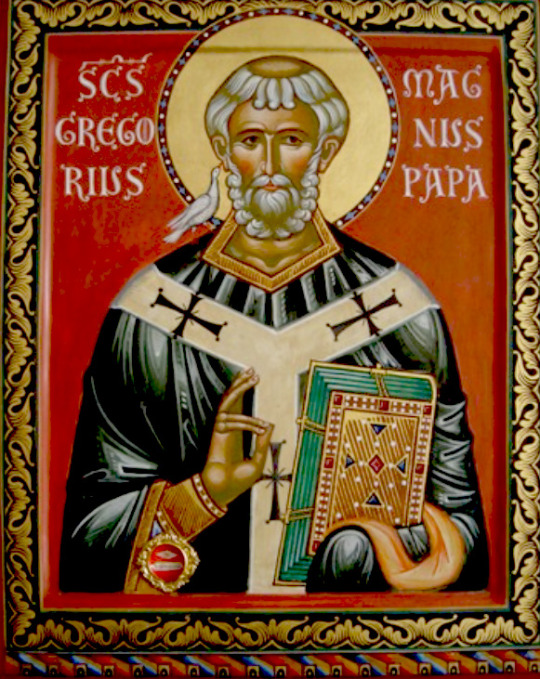
Saint Gregory the Dialogist, Pope of Rome, was born in Rome around the year 540. His grandfather was Pope Felix, and his mother Sylvia (November 4) and aunts Tarsilla and Emiliana were also numbered among the saints by the Roman Church. Having received a most excellent secular education, he attained high government positions.
Leading a God-pleasing life, he yearned for monasticism with all his soul. After the death of his father, Saint Gregory used his inheritance to establish six monasteries. At Rome he founded a monastery dedicated to the holy Apostle Andrew the First-Called, where he received monastic tonsure. Later, on a commission of Pope Pelagius II, Saint Gregory lived for a while in Constantinople. There he wrote his Commentary on the Book of Job.
After the death of Pope Pelagius, Saint Gregory was chosen to the Roman See. For seven months he would not consent to accept this service, considering himself unworthy. He finally accepted consecration only after the persistent entreaties of the clergy and flock.
Wisely leading the Church, Saint Gregory worked tirelessly in propagating the Word of God. Saint Gregory compiled the Liturgy of the Presanctified Gifts in the Latin language, which before him was known only in the verbal tradition. Affirmed by the Sixth Ecumenical Council, this liturgical service was accepted by all the Orthodox Church.
He zealously struggled against the Donatist heresy; he also converted the inhabitants of Brittany, pagans and Goths, who had been adhering to the Arian heresy, to the True Faith.
Saint Gregory has left behind numerous written works. After the appearance of his book, DIALOGUES CONCERNING THE LIFE AND MIRACLES OF THE ITALIAN FATHERS (DIALOGI DE VITA ET MIRACULIS PATRUM ITALIORUM), the saint was called “Dialogus.” His PASTORAL RULE (or LIBER REGULAE PASTORALIS) was well-known. In this work, Saint Gregory describes the model of the true pastor. His letters (848), dealing with moral guidance, have also survived.
Saint Gregory headed the Church for thirteen years, ministering to all the needs of his flock. He was characterized by an extraordinary love of poverty, for which he was granted a vision of the Lord Himself.
As he is known, Pope Saint Gregory the Great died in the year 604, and his relics rest in the cathedral of the holy Apostle Peter in the Vatican.
VENERABLE SYMEON, THE NEW THEOLOGIAN (1022)
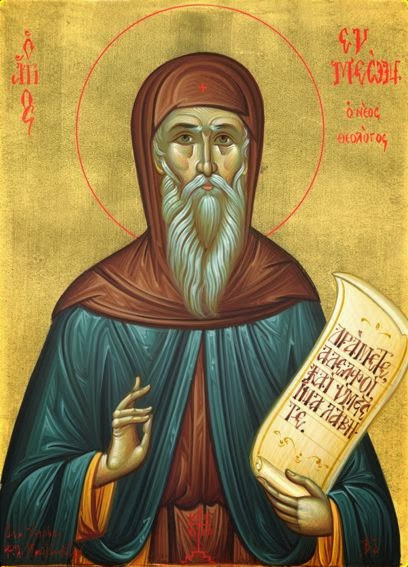
Saint Simeon the New Theologian was born in the year 949 in the city of Galatea (Paphlagonia), and he was educated at Constantinople. His father prepared him for a career at court, and for a certain while the youth occupied a high position at the imperial court. When he was fourteen, he met the renowned Elder Simeon the Pious at the Studion Monastery, who would be a major influence in his spiritual development. He remained in the world for several years preparing himself for the monastic life under the Elder’s guidance, and finally entered the monastery at the age of twenty-seven.
Saint Simeon the Pious recommended to the young man the writings of Saint Mark the Ascetic (March 5) and other spiritual writers. He read these books attentively and tried to put into practice what he read. Three points made by Saint Mark in his work “On the Spiritual Law” (see Vol. I of the English Philokalia) particularly impressed him. First, you should listen to your conscience and do what it tells you if you wish your soul to be healed (Philokalia, p. 115). Second, only by fulfilling the commandments can one obtain the activity of the Holy Spirit. Thirdly, one who prays only with the body and without spiritual knowledge is like the blind man who cried out, “Son of David, have mercy upon me” (Luke 18:38) (Philokalia, p. 111). When the blind man received his sight, however, he called Christ the Son of God (John 9:38).
Saint Simeon was wounded with a love for spiritual beauty, and tried to acquire it. In addition to the Rule given him by his Elder, his conscience told him to add a few more Psalms and prostrations, and to repeat constantly, “Lord Jesus Christ, have mercy upon me.” Naturally, he heeded his conscience.
During the day, he cared for the needs of people living in the palace of Patricius. At night, his prayers grew longer and he remained praying until midnight. Once, as he was praying in this way, a most brilliant divine radiance descended upon him and filled the room. He saw nothing but light all around him, and he was not even aware of the ground beneath his feet.
It seemed to him that he himself became light. Then his mind rose upward to the heavens, and he saw a second light brighter than the light which surrounded him. Then, on the edge of this second light, he seemed to see Saint Simeon the Pious, who had given him Saint Mark the Ascetic to read.
Seven years after this vision, Saint Simeon entered the monastery. There he increased his fasting and vigilance, and learned to renounce his own will.
The Enemy of our salvation stirred up the brethren of the monastery against Saint Simeon, who was indifferent to the praises or reproaches of others. Because of the increased discontent in the monastery, Saint Simeon was sent to the Monastery of Saint Mamas in Constantinople.
There he was tonsured into the monastic schema, and increased his spiritual struggles. He attained to a high spiritual level, and increased his knowledge of spiritual things through reading the Holy Scriptures and the writings of the Fathers, as well as in conversation with holy Elders.
Around the year 980, Saint Simeon was made igumen of the monastery of Saint Mamas and continued in this office for twenty-five years. He repaired and restored the monastery, which had suffered from neglect, and also brought order to the life of the monks.
The strict monastic discipline, for which Saint Simeon strove, led to great dissatisfaction among the brethren. Once, after Liturgy, some of the monks attacked him and nearly killed him. When the Patriarch of Constantinople expelled them from the monastery and wanted to hand them over to the civil authorities, Saint Simeon asked that they be treated with leniency and be permitted to live in the world.
About the year 1005, Saint Simeon resigned his position as igumen in favor of Arsenius, while he himself settled near the monastery in peace. There he composed his theological works, portions of which appear in the Philokalia.
The chief theme of his works is the hidden activity of spiritual perfection, and the struggle against the passions and sinful thoughts. He wrote instructions for monks: “Theological and Practical Chapters,” “A Treatise on the Three Methods of Prayer,” (in Vol. IV of the English Philokalia) and “A Treatise on Faith.” Moreover, Saint Simeon was an outstanding church poet. He also wrote “Hymns of Divine Love,” about seventy poems filled with profound prayerful meditations.
The sublime teachings of Saint Simeon about the mysteries of mental prayer and spiritual struggle have earned him the title “the New Theologian.” These teachings were not the invention of Saint Simeon, but they had merely been forgotten over time.
Some of these teachings seemed unacceptable and strange to his contemporaries. This led to conflict with Constantinople’s church authorities, and Saint Simeon was banished from the city. He withdrew across the Bosphorus and settled in the ancient monastery of Saint Makrina.
The saint peacefully fell asleep in the Lord in the year 1021. During his life he received the gift of working miracles. Numerous miracles also took place after his death; one of them was the miraculous discovery of his icon.
His Life was written by his cell-attendant and disciple, Saint Nicetas Stethatos.
Since March 12 falls during Great Lent, Saint Simeon’s Feast is transferred to October 12.
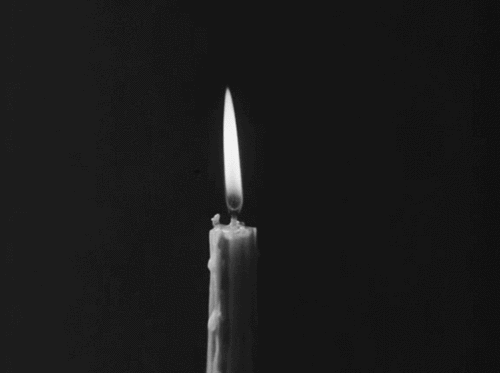
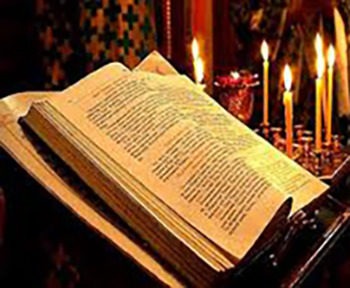
ISAIAH 4:2-5:7
2 In that day the Branch of the Lord shall be beautiful and glorious; And the fruit of the earth shall be excellent and appealing For those of Israel who have escaped. 3 And it shall come to pass that he who is left in Zion and remains in Jerusalem will be called holy—everyone who is recorded among Jerusalem's people. 4 When the Lord has washed away the filth of the daughters of Zion, and purged the blood of Jerusalem from her midst, by the spirit of judgment and by the spirit of burning, 5 then the Lord will create above every dwelling place of Mount Zion, and above her assemblies, a cloud and smoke by day and the shining of a flaming fire by night. For over all the glory, there will be a covering. 6 And there will be a tabernacle for shade in the daytime from the heat, a place of refuge, and a shelter from storm and rain.
1 Now let me sing to my Well-beloved A song of my Beloved regarding His vineyard: My Well-beloved has a vineyard On a fruitful hill. 2 He dug it up and cleared out its stones, And planted it with the choicest vine. He built a tower in its midst and also made a winepress in it. He expected it to bring forth good grapes, but it brought forth wild grapes. 3 “And now, O inhabitants of Jerusalem and men of Judah, Judge, please, between Me and My vineyard. 4 What more could have been done to My vineyard That I have not done in it? Why then, when I expected it to bring forth good grapes, Did it bring forth wild grapes? 5 And now, please let Me tell you what I will do to My vineyard: I will take away its hedge, and it shall be burned, And break down its wall, and it shall be trampled down. 6 I will lay it waste; It shall not be pruned or dug, but briers and thorns shall come
. I will also command the clouds That they rain no rain on it.” 7 For the vineyard of the Lord of hosts is the house of Israel, And the men of Judah are His pleasant plant. He looked for justice, but behold oppression; For righteousness, but behold, a cry for help.
GENESIS 3:21-4:7
21 Also for Adam and his wife the Lord God made tunics of skin, and clothed them. 22 Then the Lord God said, “Behold, the man has become like one of Us, to know good and evil. And now, lest he put out his hand and take also of the tree of life, and eat, and live forever”— 23 therefore the Lord God sent him out of the garden of Eden to till the ground from which he was taken. So He drove out the man; and He placed cherubim at the east of the garden of Eden, and a flaming sword which turned every way, to guard the way to the tree of life.
1 Now Adam knew Eve his wife, and she conceived and bore Cain, and said, “I have acquired a man from the Lord.” 2 Then she bore again, this time his brother Abel. Now Abel was a keeper of sheep, but Cain was a tiller of the ground. 3 And in the process of time it came to pass that Cain brought an offering of the fruit of the ground to the Lord. 4 Abel also brought of the firstborn of his flock and of their fat. And the Lord respected Abel and his offering, 5 but He did not respect Cain and his offering. And Cain was very angry, and his countenance fell. 6 So the Lord said to Cain, “Why are you angry? And why has your countenance fallen? 7 “If you do well, will you not be accepted? And if you do not do well, sin lies at the door. And its desire is for you, but you should rule over it.”
#orthodoxy#orthodoxchristianity#easternorthodoxchurch#originofchristianity#spirituality#holyscriptures#bible#wisdom#saints
4 notes
·
View notes
Note
Is the Church responsible for women’s constant suffering? This is not a gotcha or a troll I just read and hear so many different things (not just from “cultural Catholics”, but from magisterial documents and official sources and well educated practitioners who are infinitely more knowledgeable in history and doctrine than I will ever be) in regards to “women’s role in society” and sometimes I become.. concerned. Almost everything I’ve read and heard about Catholic doctrine and ideals (from Catholics and magisterial documents, not from atheists or anti-Catholics or feminists) makes it seem like the Church would prefer that women.. not do anything. (Insert renowned female saint or queen here) would be an exception to the rule, everything I’ve read makes it seem like in an ideal Catholic world, women should not strive for anything besides either being a nun or a mother (not that these are bad things, they’re the backbone of society). And sometimes this troubles me. Sometimes I wonder if the anti-Catholics are right. I mean yes the Church seems to respect women more than the secular world…. but that’s a very low bar.
Hey anon! Thank you for the question :)
Unfortunately, I am not a theologian, and also my brain is fried lol, so I’m not going to be giving that detailed of an answer, sorry…..
Basically, the long and short of it as I know it is that the Church itself (actual dogma, etc) is absolutely in no way, shape, or form trying to keep women “hidden” in that way. But yeah, things are super confusing when you add actual humans and they’re opinions/cultures/biases/etc. into the mix, which, you know, surprise surprise. There are definitely other Catholics who have views on that topic that seem a little off to me (though often times a lot of the difference is just the way we view things/define terms. Not always though.)
But the Church holds that both men and women have the same vocation options: marriage, religious life, and consecrated single-hood. This third option generally lends itself to doing more work or ministry out in the world, since you don’t have an obligation to your spouse/kids or religious community and bishop/superior. Anyone who tells you that this isn’t an option for women is plain wrong. And even if those female saints seem like the “exception,” they wouldn’t be saints if their life’s work went against the church (and also, the male saints have similar roles/lives to those of the female saints — some are more active, some more contemplative, etc).
So yeah….. sorry I can’t be more helpful :( I think this is just… a very multifaceted and complicated problem, but one that is more on the human level rather than the magisterial. But while there are definitely some Catholics that have…..iffy opinions, I also know a LOT of faithful Catholics who absolutely are not like that and don’t think that women shouldn’t be in society, etc.
As an addendum, here is Pope St. John Paul II’s letter to women given at the UN: https://www.vatican.va/content/john-paul-ii/en/letters/1995/documents/hf_jp-ii_let_29061995_women.html
#thanks for the ask!#hopefully this isn’t too insufficient….#catholic#to be clear#no I don’t think the church is responsible for women’s constant suffering#historically they did a lot to improve women’s condition in the world#but humans can suck :/
16 notes
·
View notes
Text
"January 22, 2024 is not merely a date in the calendar but heralds the advent of a new era," Modi said, speaking outside the temple to the Hindu deity Ram, built on grounds where a mosque stood for centuries before it was torn down in 1992 by Hindu zealots incited by members of his party.
That demolition triggered the worst religious riots since independence – killing 2,000 people, most of them Muslims – and shook the foundations of India's officially secular political order.
Tens of thousands of chanting and dancing devotees waving flags, honking horns and beating drums have converged on the northern town of Ayodhya, with roads clogged, trains packed full and the rest marching in on foot.
Few members of Ayodhya's Muslim community were seen joining the jubilant street party.
But for Modi's ruling Bharatiya Janata Party (BJP), the opening of the Ram Mandir temple is a landmark moment in a decades-long campaign to align the country's governance with its majority faith.
"The Lord has made me an instrument to represent all the people of India", Modi said when he launched an 11-day ritual fast ahead of the "auspicious" opening.
Tycoons, cricketers and actors
Excitement has reached a fever pitch, with thousands of Hindu believers dancing in packed streets as giant loudspeakers blast out religious tunes.
Vijay Kumar, 18, took four days to reach the town after walking and hitchhiking 600 kilometres (370 miles).
"We just wanted to be here," Kumar said. "We just wish to see the temple before we leave."
About 2,500 musicians are expected to perform on over 100 stages for the crowds of pilgrims, desperate to see the elaborate temple, built at an estimated $240 million that the project's backers say was sourced from public donations.
The 140 kilometres (87 miles) between the town and Uttar Pradesh state capital Lucknow is a seemingly endless stream of billboards of blue-skinned Ram with bow and arrow – as well as of Modi and the region's chief minister, the saffron-robed Hindu monk Yogi Adityanath.
Bukesh Rajiybng, 54, travelled for three days in a jam-packed train to attend the celebration.
"It's a moment we have all dreamed of for decades," he said. "I think the people and Ram will definitely bless Modi for this."
Other attendees jetted in to the newly built international airport and will stay at a crop of hotels built to cater to the millions of pilgrims expected to visit each year.
Among the celebrity guests at the opening are Indian tycoons, former national cricket captain Virat Kohli and Bollywood titan Amitabh Bachchan.
'Death and destruction'
Modi and the BJP have sought to bring the Hindu faith to the forefront of public life since sweeping to power a decade ago.
Party luminaries regularly condemn earlier eras of Islamic rule over parts of India as a time of "slavery" when their own religion was oppressed, with Ayodhya a key plank in their narrative.
Devout Hindus believe Ram, one of the most revered Hindu gods, was born in the town more than 7,000 years ago, but that the Babri mosque was built over his birthplace by a 16th-century Muslim emperor.
The BJP played an instrumental role in public campaigning that eventually led to the mosque's demolition.
The destruction presaged the rise of the BJP and Modi as unstoppable electoral juggernauts, displacing the secularist Congress party that had governed India almost without interruption since independence from Britain.
Modi's consecration of the temple alongside Hindu priests will again project him as a defender of the faith ahead of a general election expected to begin in April.
The BJP is heavily favoured to win a third successive landslide victory, in part because of Modi's appeals to Hindu nationalism, and opposition parties are boycotting the temple ceremony, saying the event will be a thinly veiled campaign rally.
Many of India's 200 million Muslims, already anxious in a climate of increased sectarian tensions, have watched the clamour around the temple with trepidation.
Mohammed Shahid, 52, speaking to AFP last month in Ayodhya, recounted how his father was burned alive by a mob.
"For me, the temple symbolises nothing but death and destruction", he said.
3 notes
·
View notes
Text
A cultured society that has fallen away from its religious traditions expects more from art than the aesthetic consciousness and the 'standpoint of art' can deliver. The Romantic desire for a new mythology... gives the artist and his task in the world the consciousness of a new consecration. He is something like a 'secular saviour' for his creations are expected to achieve on a small scale the propitiation of disaster for which an unsaved world hopes.
~ Hans-Georg Gadamer
#hans georg gadamer#gadamer#quotes#art#desire#religion#world#hope#traditions#philosophy#hermeneutics
15 notes
·
View notes